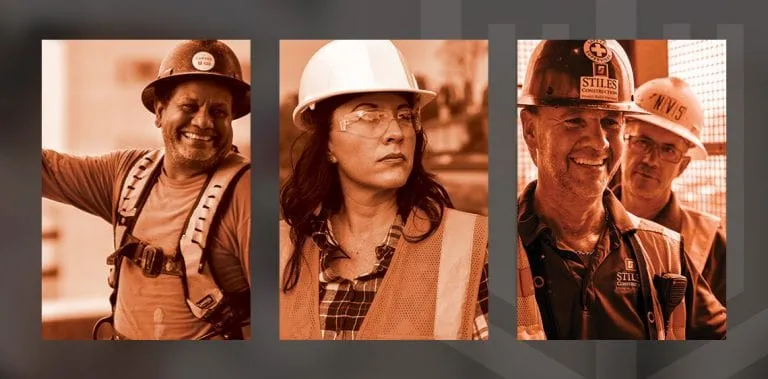
It is not uncommon to have assumptions or stereotypes about a particular industry and the people who work there. It is no secret that construction workers take a reputational low blow in today’s culture.
We are not:
Dirty.
Uneducated.
Underpaid.
Don’t worry. We’re fully aware of what some folks think of us. We just don’t care. We know the truth and like everything else – it’s more nuanced than many would like to bother with.
Sure, the “office” of a construction worker and the daily life of a doctor are tremendously different, but that doctor needs us to build her or his facilities and we’ll all probably need a doctor at some point. The career paths are worlds apart, however, one cannot exist without the other. So, while we are different, we are both essential to society.
We know who we are and we’re damn proud of it.
Historically, the construction industry has been dominated by men but that is changing. From 1985 – 2017 there was an 81.3% increase in the number of women employed in construction. While these women are taking charge across the industry, they still only comprised of 18% of the architects and 17.5% of civil, architectural and sanitary engineers as of 2017. True, men still make up the majority of the workforce, but women are quickly catching up. Please join us. Our very own Heather Novak can attest to this. After realizing college wasn’t for her, she decided to take a chance. She joined Local 513 of the International Union of Operating Engineers. Her apprenticeship was three years long and it led her to where she is now, a position she loves.
“I still come into work and learn something new some days. It’s the people who were around me when I started that were willing to take a chance on me. I’ve had to prove myself, but it has been so worth it. It’s where I belong. Not in a man’s world; more like ‘Heather’s World!’” – Heather Novak, pictured right
There’s a belief that anyone can get a job in the construction industry and, therefore, it is beneath those with college degrees. Get through high school, trade school, college, post-graduate or doctoral studies. We’re happy to have you. Folks are different. Just a couple of rules:
We’re not all that different than the rest of life. We’re just cooler.
Construction is a multi-billion-dollar industry. From building residential homes to paving highways, there’s an opportunity for any construction worker to earn a very decent living. Based on Glassdoor’s national 2018/2019 survey, the average base pay of a Construction Project Manager is $97,595/year. You don’t need a 4 years of college to make a living, either. The prevailing wage for a construction laborer in St. Louis is $47.50/hour. Take a wild guess where most Project Superintendents come from.
We may be on the edge of something sometimes but we’re always safe. The development of safety programs and regulations, as well as regular safety meetings and the updating of risk management plans continue to protect crews and the communities we serve. Safety will always come first.
“While it is true the construction industry can be inherently dangerous, having a quality comprehensive written safety & health program in place can greatly reduce occupational hazards, risk, and employee injuries. It is imperative that the safety program be fully supported from top management and driven down to all levels of management all the way down to field employees where everyone is held accountable for safe work practices.
Currently, the Total Recordable Incident rate for heavy highway and bridge building construction is a 3.5. Millstone Weber is currently well below the industry average at a 1.9. Through top management support, proper planning, safe work practices, employee engagement, and accountability has proven that construction work can be completed safely where hazards, risk, and injuries are greatly reduced!” – Eric Waterkotte, Safety Director
Do me a favor and look around. What do you see? The walls of a building that you’re in? A road that you’re drivng on? A bridge connecting two cities? All that stuff was built by somebody.
Most people haven’t tried to understand what actually goes into being a part of the construction world. So, as a result, stereotypes have become one of the leading causes in the decline of the people coming into this business, even though the work itself never stops.
Mike Rowe said it best:
“We’ve got millions of people looking for work and millions of jobs that nobody wants. College graduates are a trillion dollars in debt and struggling to find employment in their field of study. Meanwhile, 88% of all the available jobs don’t require a four-year degree. They require specific training. So, what do we do? We push a four-year degree like it’s some sort of Golden Ticket. We remove vocational education from high schools at the time we need it most. We’re lending money we don’t have to kids who can’t pay it back, educating them for jobs that no longer exist. I’m no expert, but I’d say that’s profoundly disconnected.”
To be clear, no one is telling anyone what to do with his or her life. We’re simply saying that, maybe, there are more options out there than you think.
You just need to keep an open mind. Ask questions and be open to new experiences. Yes, we need doctors and lawyers and people in professions of all kinds; but we also need people to keep our communities moving forward. Face it, we’re basically wizards with a crane and a hard-hat instead of a sword and stone.
Whether or not construction work is your calling (that’s why it’s Your calling) no one can deny the important role these folks play in society.